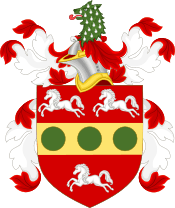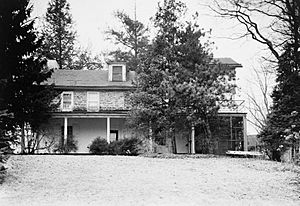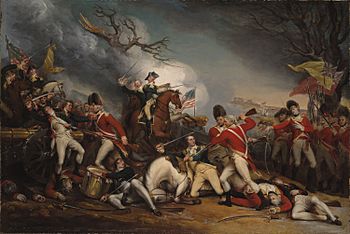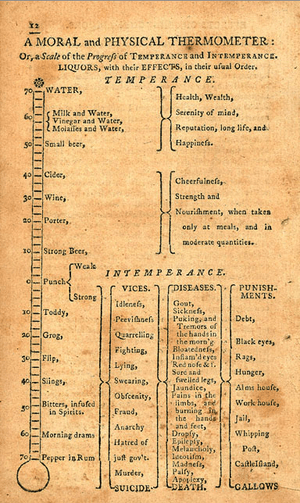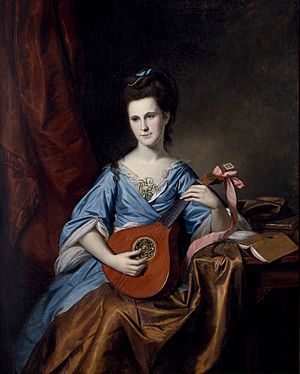Benjamin Rush facts for kids
Quick facts for kids
Benjamin Rush
|
|
|---|---|
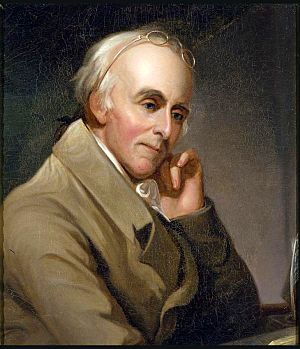
Portrait by Charles Willson Peale, c. 1818
|
|
| Born | January 4, 1746 |
| Died | April 19, 1813 (aged 67) |
| Resting place | Christ Church Burial Ground, Philadelphia |
| Alma mater | Princeton University University of Edinburgh |
| Occupation | Physician, writer, educator, medical doctor |
| Known for | Signer of the United States Declaration of Independence |
| Children | 13, including Richard |
| Signature | |
Benjamin Rush (January 4, 1746 [O.S. December 24, 1745] – April 19, 1813) was a Founding Father of the United States who signed the United States Declaration of Independence, and a civic leader in Philadelphia, where he was a physician, politician, social reformer, humanitarian, educator, and the founder of Dickinson College. Rush was a Pennsylvania delegate to the Continental Congress. His later self-description there was: "He aimed right." He served as surgeon general of the Continental Army and became a professor of chemistry, medical theory, and clinical practice at the University of Pennsylvania.
Rush was a leader of the American Enlightenment and an enthusiastic supporter of the American Revolution. He was a leader in Pennsylvania's ratification of the U.S. Constitution in 1788. He was prominent in many reforms, especially in the areas of medicine and education. He opposed slavery, advocated free public schools, and sought improved education for women and a more enlightened penal system. As a leading physician, Rush had a major impact on the emerging medical profession. As an Enlightenment intellectual, he was committed to organizing all medical knowledge around explanatory theories, rather than rely on empirical methods. Rush argued that illness was the result of imbalances in the body's physical system and was caused by malfunctions in the brain. His approach prepared the way for later medical research, but Rush undertook none of it. He promoted public health by advocating clean environment and stressing the importance of personal and military hygiene. His study of mental disorder made him one of the founders of American psychiatry. In 1965, the American Psychiatric Association recognized Rush as the "father of American psychiatry".
Contents
Early life and career
Rush was born to John Rush and Susanna Hall on January 4, 1746 (December 24, 1745 O.S.). The family, of English descent, lived on a farm in the Township of Byberry in Philadelphia County, about 14 miles outside of Philadelphia (the township was incorporated into Philadelphia in 1854). Rush was the fourth of seven children. His father died in July 1751 at age 39, leaving his mother, who ran a country store, to care for the family. At age eight, Benjamin was sent to live with an aunt and uncle to receive an education. He and his older brother Jacob attended a school run by Reverend Samuel Finley, which later became West Nottingham Academy.
In 1760, after further studies at the College of New Jersey (which in 1895 changed its name to its present name, Princeton University), Rush graduated with a Bachelor of Arts degree at age fourteen. From 1761 to 1766, Rush apprenticed under Dr. John Redman in Philadelphia. Redman encouraged him to further his studies at the University of Edinburgh in Scotland, where Rush studied from 1766 to 1768 and earned an M. D. degree. Rush became fluent in French, Italian, and Spanish as a result of his studies and European tour. While at Edinburgh, he became a friend of the Earl of Leven and his family, including William Leslie.
Returning to the Colonies in 1769, Rush opened a medical practice in Philadelphia and became professor of chemistry at the College of Philadelphia (which in 1791 changed its name to its present name, University of Pennsylvania). After his election to the revived American Philosophical Society in 1768, Rush served as the society's curator from 1770 to 1773, as secretary from 1773 to 1773, and vice president from 1797 to 1801. Rush ultimately published the first American textbook on chemistry and several volumes on medical student education and wrote influential patriotic essays.
Revolutionary period
Rush was active in the Sons of Liberty and was elected to attend the provincial conference to send delegates to the Continental Congress. Thomas Paine consulted Rush when writing the profoundly influential pro-independence pamphlet Common Sense. Starting in 1776, Rush represented Pennsylvania and signed the Declaration of Independence. He also represented Philadelphia at Pennsylvania's own Constitutional Convention.
While Rush was representing Pennsylvania in the Continental Congress (and serving on its medical committee), he also used his medical skills in the field. Rush accompanied the Philadelphia militia during the battles after which the British occupied Philadelphia and most of New Jersey. He was depicted serving in the Battle of Princeton in the painting The Death of General Mercer at the Battle of Princeton, January 3, 1777 by the American artist John Trumbull.
The Army Medical Service was in disarray, between the military casualties, extremely high losses from typhoid, yellow fever and other camp illnesses, political conflicts between Dr. John Morgan and Dr. William Shippen, Jr., and inadequate supplies and guidance from the medical committee. Nonetheless, Rush accepted an appointment as surgeon-general of the middle department of the Continental Army. Rush's order "Directions for preserving the health of soldiers" became one of the foundations of preventive military medicine and was repeatedly republished, including as late as 1908. However, Rush's reporting of Dr. Shippen's misappropriation of food and wine supplies intended to comfort hospitalized soldiers, under-reporting of patient deaths, and failure to visit the hospitals under his command, ultimately led to Rush's resignation in 1778.
Post-Revolution
In 1783, he was appointed to the staff of Pennsylvania Hospital, and he remained a member until his death. He was elected to the Pennsylvania convention which adopted the Federal constitution and was appointed treasurer of the United States Mint, serving from 1797 to 1813. He was elected a fellow of the American Academy of Arts and Sciences in 1788.
He became a professor of medical theory and clinical practice at the University of Pennsylvania in 1791, though the quality of his medicine was quite primitive even for the time: he advocated bloodletting for almost any illness, long after its practice had declined. While teaching at the University of Pennsylvania, one of his students was future president William Henry Harrison, who took a chemistry class from Rush. He became a social activist and an abolitionist and was the most well-known physician in America at the time of his death.

He was also founder of Dickinson College in Carlisle, Pennsylvania. In 1794, he was elected a foreign member of the Royal Swedish Academy of Sciences. In the 1793 Philadelphia yellow fever epidemic, Rush treated patients with bleeding, calomel, and other early medicinal techniques that often were ineffective and actually brought many patients closer to their deathbeds. Rush's ideas on yellow fever treatments differed from those of many experienced French doctors, who came from the West Indies where they had yellow fever outbreaks every year.
Rush was a founding member of the Philadelphia Society for Alleviating the Miseries of Public Prisons (known today as the Pennsylvania Prison Society), which greatly influenced the construction of Eastern State Penitentiary in Philadelphia. He supported Thomas Jefferson for president in 1796 over the eventual winner, John Adams.
Corps of Discovery
In 1803, Jefferson sent Meriwether Lewis to Philadelphia to prepare for the Lewis and Clark Expedition under the tutelage of Rush, who taught Lewis about frontier illnesses and the performance of bloodletting. Rush provided the corps with a medical kit that, among other things, included fifty dozen of Dr. Rush's Bilious Pills, laxatives containing more than 50% mercury, which have since colloquially been referred to as "thunderclappers." Their meat-rich diet and lack of clean water during the expedition gave the men cause to use them frequently. Although their efficacy is questionable, their high mercury content provided an excellent tracer by which archaeologists have been able to track the corps' actual route to the Pacific.
Reforms
Anti-slavery
In 1766, when Rush set out for his studies in Edinburgh, he was outraged by the sight of 100 slave ships in Liverpool harbor. As a prominent Presbyterian doctor and professor of chemistry in Philadelphia, he provided a bold and respected voice against the slave trade.
Anti-capital punishment
Rush deemed public punishments such as putting a person on display in stocks, common at the time, to be counterproductive. Instead, he proposed private confinement, labor, solitude, and religious instruction for criminals, and he opposed the death penalty. His outspoken opposition to capital punishment pushed the Pennsylvania legislature to abolish the death penalty for all crimes other than first-degree murder.
Rush led the state of Pennsylvania to establish the first state penitentiary, the Walnut Street Prison, in 1790. Rush campaigned for long-term imprisonment, the denial of liberty, as both the most humane but severe punishment. This 1792 treatise was preceded by comments on the efficacy of the death penalty that he self-references and which, evidently, appeared in the second volume of the American Museum.
Status of women
After the Revolution, Rush proposed a new model of education for elite women that included English language, vocal music, dancing, sciences, bookkeeping, history, and moral philosophy. He was instrumental to the founding of the Young Ladies' Academy of Philadelphia, the first chartered women's institution of higher education in Philadelphia. Rush saw little need for training women in metaphysics, logic, mathematics, or advanced science; rather he wanted the emphasis on guiding women toward moral essays, poetry, history, and religious writings. This type of education for elite women grew dramatically during the post-revolutionary period, as women claimed a role in creating the Republic. And so, the ideal of Republican motherhood emerged, lauding women's responsibility of instructing the young in the obligations of patriotism, the blessings of liberty and the true meaning of Republicanism. He opposed coeducational classrooms and insisted on the need to instruct all youth in the Christian religion.
Medical contributions
Physical medicine
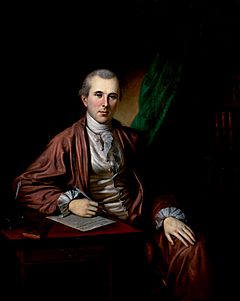
Rush was a leading proponent of heroic medicine. He firmly believed in such practices as bloodletting patients (a practice now known to be generally harmful, but at the time common practice), as well as purges using calomel and other toxic substances. During the Philadelphia yellow fever epidemic of 1793, Rush gained acclaim for remaining in town and treating sometimes 100 patients per day.
Another of Rush's medical views that now draws criticism is his analysis of race. In reviewing the case of Henry Moss, a slave who lost his dark skin color (probably through vitiligo), Rush characterized being black as a hereditary and curable skin disease. Rush wrote that the "disease, instead of inviting us [whites] to tyrannise over them [blacks], it should entitle them to a double portion of our humanity."
Rush was interested in Native American health. He wanted to find out why Native Americans were susceptible to certain illnesses and whether they had higher mortality rates as compared to other people. Other questions that he raised were whether dreamed more and if their hair turned gray as they got older. His fascination with these people came from his interest in the theory that social scientists can better study the history of their own civilization by studying cultures in earlier stages of development, "primitive men".
Mental health
Rush published one of the first descriptions and treatments for psychiatric disorders in American medicine, Medical Inquiries and Observations, Upon the Diseases of the Mind (1812). He undertook to classify different forms of mental illness and to theorize as to their causes and possible cures. After seeing mental patients in appalling conditions in Pennsylvania Hospital, Rush led a successful campaign in 1792 for the state to build a separate mental ward where the patients could be kept in more humane conditions.
Rush advocated for more humane mental institutions and perpetuated the idea that people with mental illness are people who have an illness, rather than inhuman animals. The American Psychiatric Association's seal bears an image of Rush's purported profile at its center.
Educational legacy
During his career, he educated over 3,000 medical students, and several of these established Rush Medical College in Chicago in his honor after his death. His students included Valentine Seaman, who mapped yellow fever mortality patterns in New York and introduced the smallpox vaccine to the United States in 1799. One of his last apprentices was Samuel A. Cartwright, later a Confederate States of America surgeon charged with improving sanitary conditions in the camps around Vicksburg, Mississippi, and Port Hudson, Louisiana. Rush University Medical Center in Chicago, formerly Rush-Presbyterian-St. Luke's Medical Center, was named in his honor.
Religious views and vision
Rush advocated Christianity in public life and in education. He regularly attended Christ Church in Philadelphia and counted William White among his closest friends (and neighbors).
Rush fought for temperance and both public and Sunday schools. He helped found the Bible Society at Philadelphia (now known as the Pennsylvania Bible Society) and promoted the American Sunday School Union. When many public schools stopped using the Bible as a textbook, Rush proposed that the U.S. government require such use, as well as furnish an American Bible to every family at public expense.
Rush helped Richard Allen found the African Methodist Episcopal Church.
Personal life
On January 11, 1776, Rush married Julia Stockton (1759–1848), daughter of Richard Stockton, another signer of the Declaration of Independence, and his wife Annis Boudinot Stockton. They had 13 children, 9 of whom survived their first year: John, Ann Emily, Richard, Susannah (died as an infant), Elizabeth Graeme (died as an infant), Mary B, James, William (died as an infant), Benjamin (died as an infant), Richard, Julia, Samuel, and William. Richard later became a member of the cabinets of James Madison, James Monroe, John Quincy Adams, Andrew Jackson, James K. Polk, and Zachary Taylor (at one point during each of their presidencies).
In 1812, Rush helped reconcile the friendship of Jefferson and Adams by encouraging the two former presidents to resume writing to each other.
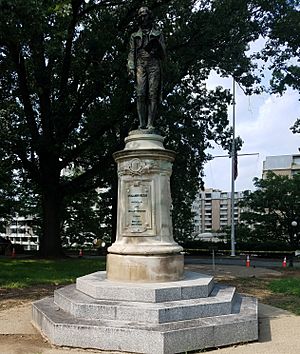
Death
After dying of typhus fever, he was buried (in Section N67) along with his wife Julia in the Christ Church Burial Ground in Philadelphia, not far from where Benjamin Franklin is buried. At the site, a small plaque honoring Benjamin Rush has been placed. However, the box marker is next to the plaque on the right, with inscriptions on the top. The inscription reads,
"In memory of
Benjamin Rush MD
he died on the 19th of April
in the year of our Lord 1813
Aged 68 years
Well done good and faithful servant
enter thou into the joy of the Lord"
"Mrs Julia Rush
consort of
Benjamin Rush MD
Born March 2, 1759
Died July 7, 1848
For as in Adam, all die, even so in Christ
Shall all be made alive"
Legacy
Benjamin Rush Elementary School in Redmond, Washington was named by its students for him. The Arts Academy at Benjamin Rush magnet high school in Philadelphia was established in 2008. Rush County, Indiana, is named for him as is its county seat, Rushville. Rush University Medical Center in Chicago is named after Rush. Benjamin Rush State Park in Philadelphia is named after Rush. The eponymous conservative Benjamin Rush Institute is an associate member of the State Policy Network.
Archival collections
The Presbyterian Historical Society in Philadelphia, Pennsylvania, has a collection of Benjamin Rush's original manuscripts.
See also
 In Spanish: Benjamin Rush para niños
In Spanish: Benjamin Rush para niños


